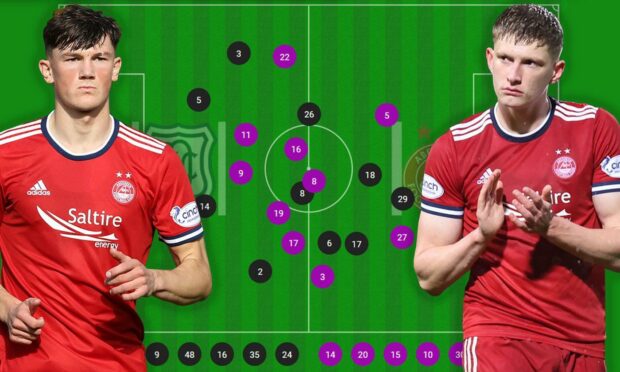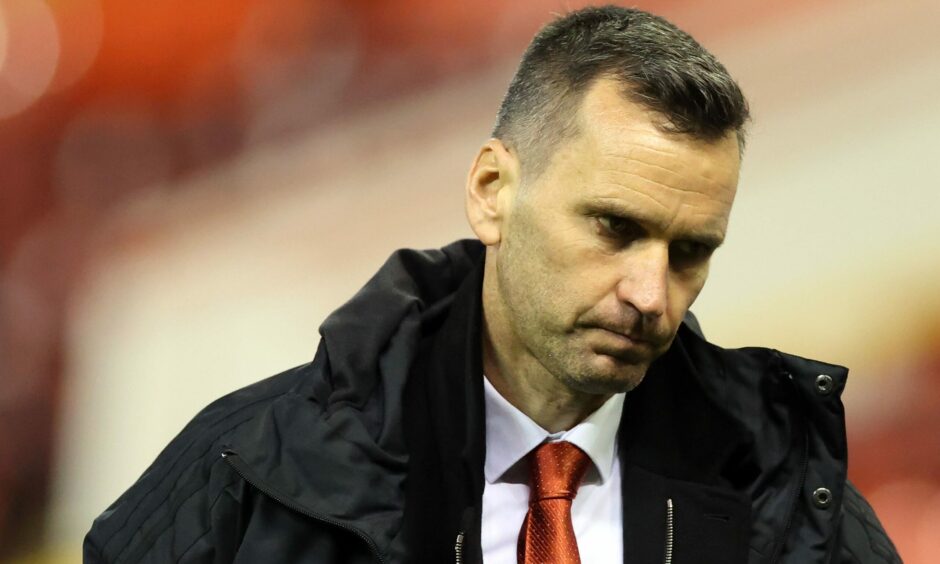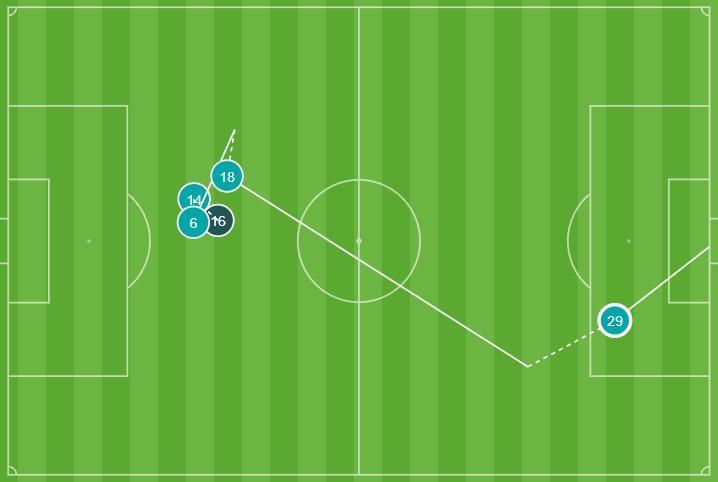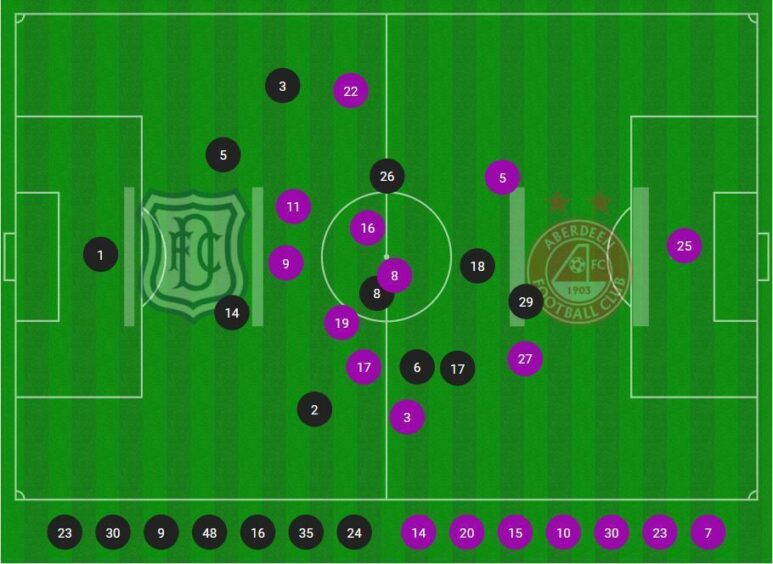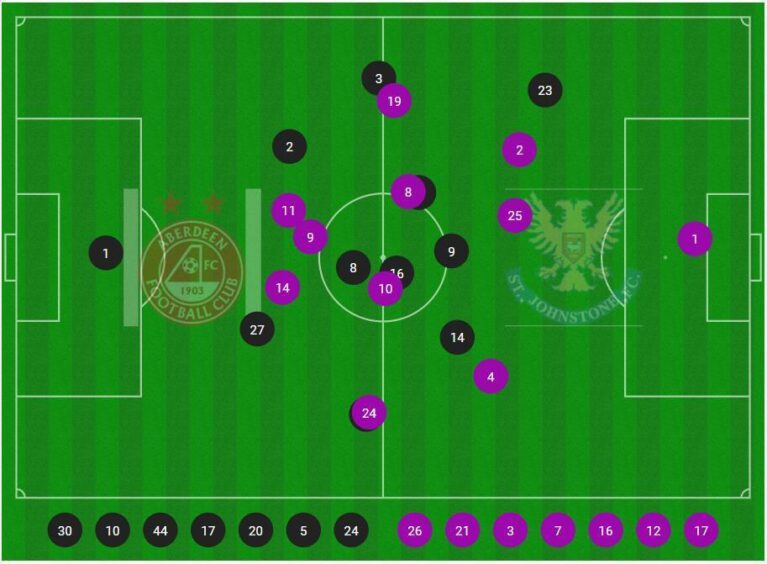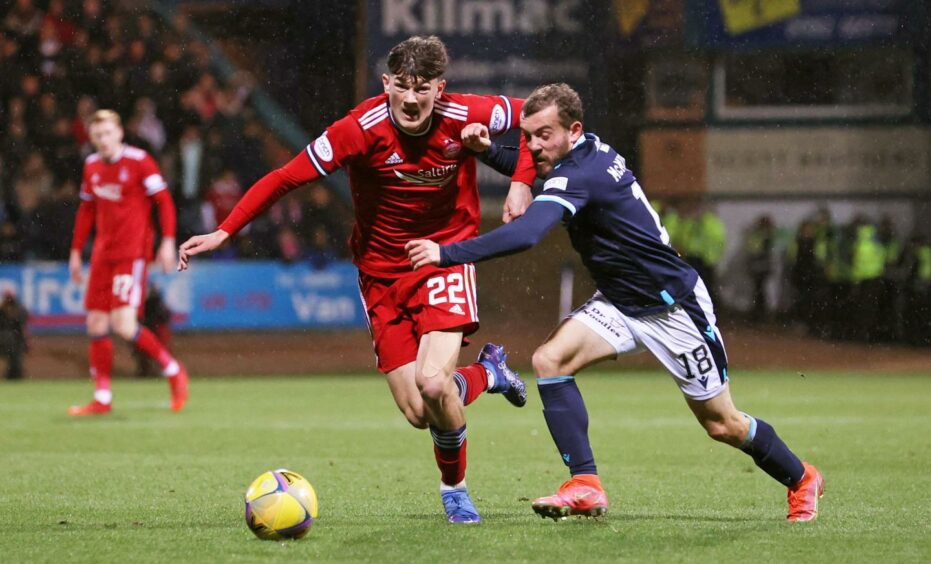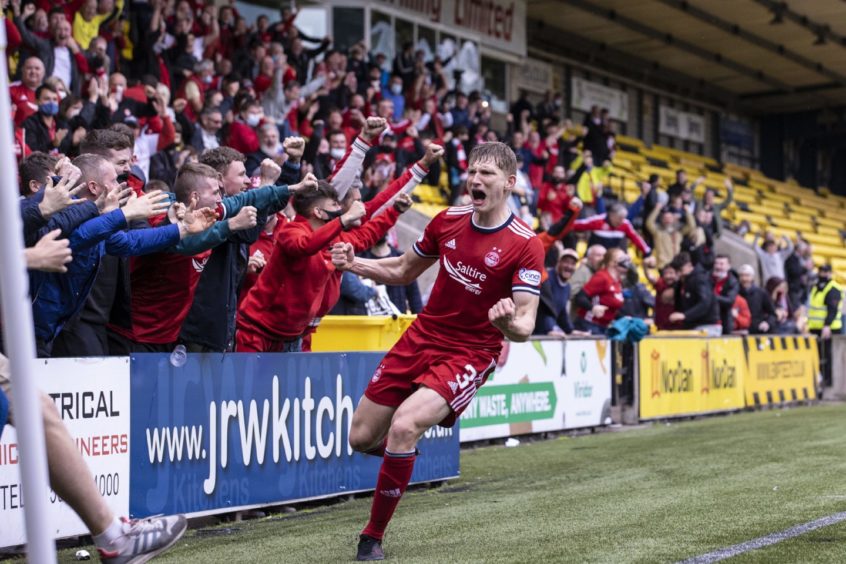Ahead of this weekend’s pressure-cooker clash with Hibs, Aberdeen boss Stephen Glass is facing several questions – including what to do with his porous defence.
In the wake of the ninth-placed Dons’ fifth loss in a row, to then-rock-bottom Dundee – which saw their winless run extend to 10 games – there has naturally been further scrutiny on the performance of the backline.
Aberdeen have a single clean sheet in their last 22 games, so even the most positive of fans would accept something is going badly wrong in defence.
Individual errors and disappointing showings from Glass’ summer reinforcements and others are part of the problem, however, another factor pundits have pointed to is the vulnerability of a four-at-the-back system where young full-backs Calvin Ramsay and Jack MacKenzie are encouraged to play high and support the attack.
Aberdeen tend to dominate possession in games, and getting these extra men forward is an attempt to overload and unlock stubborn opponents, utilising Ramsay and MacKenzie’s crossing abilities, but it creates a problem when the other team wins the ball back.
The Dons most successful ever player Willie Miller is one of those to raise this issue, in this week’s Evening Express column, writing: “Under Glass, although striker and summer signing Christian Ramirez is one of the Premiership’s top scorers, Aberdeen are struggling to even take the lead in matches due to giving up goals too easily.
“I feel Aberdeen are coming out determined to hit the front in clashes to the point where the two centre-backs – whether it’s Ross McCrorie, or Saturday’s partnership of Declan Gallagher and David Bates – are being left as the only ones defending.
“The tactics seem to be to get the full-backs, Calvin Ramsay and Jack MacKenzie, as high as they possibly can to create chances, which is the modern approach to the game and something Ramsay and MacKenzie have been doing, but it’s something which leaves the centre-backs exposed when possession is lost.”
Under-fire Glass has the continued backing of chairman Dave Cormack, but you’d think something will have to change in terms of results in a season-defining period before the end of November. It’s a run where Aberdeen meet top-six sides Hibs, Hearts, Rangers, Motherwell, Dundee United and Celtic.
Miller thinks sorting the defensive issues should be the number one priority for the manager, who was appointed to replace Derek McInnes towards the end of last term.
Reflecting on the loss at Dundee, it’s easy to see where Miller is coming from…
Griffiths’ goal exposed huge hole in Aberdeen defence
Take the Dundee opener in the second half, which made the chances of a tide-turning victory remote for the visitors.
Ryan Hedges played a poor through ball meant for Jonny Hayes on the edge of the Dundee area, which was intercepted.
After a couple of seconds of pinball, Paul McMullan picked up the ball and quickly launched it in behind the Reds defence to Celtic loanee Leigh Griffiths – a scourge of the Dons’ recent past.
On the far side, MacKenzie tried desperately to get back to help David Bates, but his starting position was too high to recover from.
On the near side, you can see Calvin Ramsay and Declan Gallagher would likely have suffered the same fate had the ball gone to Jordan McGhee.
The simplicity of the goal in graphic form is frightening:
Look at the defence’s average positions for the Dens Park clash, and particularly how high Ramsay (22) was during the (with stoppages included) 100-odd minutes of play:
As is made clear above, not all goals conceded are the fault of the high full-backs, and there have certainly been several individual errors which have contributed to goals conceded. For example, for the second goal, Funso Ojo, Bates and Gallagher are too slow to intervene, with the latter pair failing to get in front of Luke McCowan’s shot.
However, the issue with the lack of cover at full-back has been a pattern this season, as Miller and others have pointed out, and it’s not inconceivable anxieties over this are impacting on other parts of the defensive performances.
Warnings from loss to St Johnstone
Celtic’s two goals in October 3’s 2-1 defeat at Pittodrie were the result of players not getting tight enough to their men or dealing with the Hoops’ movement, and the 3-2 defeat at St Mirren before it was due in large part to Teddy Jenks’ naïve second half sending off when the Dons were in the ascendancy.
But the positioning of the full-backs was definitely a contributing factor to Stevie May’s winner for St Johnstone in the Granite City on September 18.
The Dons were given a warning against Saints, as you’ll see in the clip above, with the huge gap down the near side exposed not long before May’s goal.
In this first incident, Ali Crawford was set free down the left flank and, with the centre-backs at sixes and sevens as they laboured to get back, having been turned, the Reds were only saved when Glenn Middleton’s close-range finish was chalked off for offside.
However, Callum Davidson’s visitors clearly saw the opportunity of sending the ball up the field quickly in order to exploit Ramsay’s high position.
For May’s goal soon after, right-back Ramsay wasn’t as far up the park, but he was ahead of Ross McCrorie and, once Jonny Hayes lost the ball and Ramsay failed to intercept it as it was sent up the field to May, both Aberdeen players were unable to recover.
What now for Aberdeen’s tactical approach?
We’ve seen the problem with the high full-backs in goals conceded, the question is this – Will Glass change his attacking principles in attempt to make the back door less vulnerable and, if so, do Aberdeen have the creativity elsewhere in the team to make up for stifling Ramsay and MacKenzie?
It’s a Catch-22 for Glass and Aberdeen, because most of their chances are currently being created by those high full-backs.
Stop them going forward as much and, although you might improve defensive solidity, you lose attacking potency.
Now, whether the midfield, despite the likes of Ryan Hedges missing games this seaosn, should be bearing more of the creative burden is another question entirely.
But, the fact remains, Ramsay has assisted three of Aberdeen’s 10 Premiership goals this season, and MacKenzie has scored one of those 10, while also setting up Christian Ramirez for the Reds’ consolation goal against Dundee.
Going into the game with Dundee, Ramsay had created 22 chances in the previous six league games – more than the rest of the squad combined. MacKenzie was second.
On Saturday in Dundee, Ramsay created three chances – the joint highest in the team alongside Scott Brown – while MacKenzie made two goalscoring chances.
However, 13 goals conceded in the last eight Premiership games is the problem which must be fixed, because, if it isn’t, it could see Aberdeen drop into one of the two relegation places in the next few weeks.
The solution as has been suggested elsewhere, may be to move to a three-man back-line, with Ramsay and MacKenzie as wing-backs.
Andy Considine’s serious knee injury was a big blow, while Michael Devlin’s long fitness battle is still being fought, but would the available centre-back options – McCrorie, Bates and Gallagher – work well together in that system. Perhaps we’ll find out.
